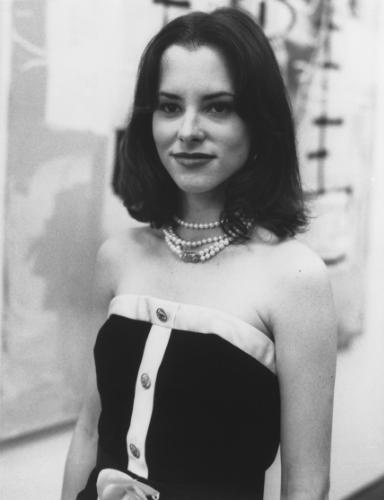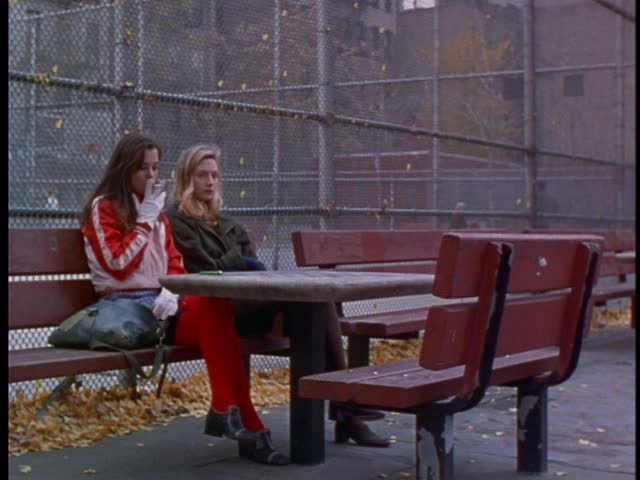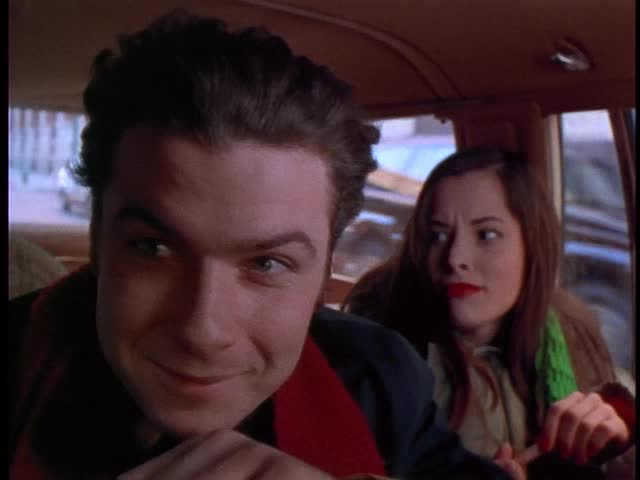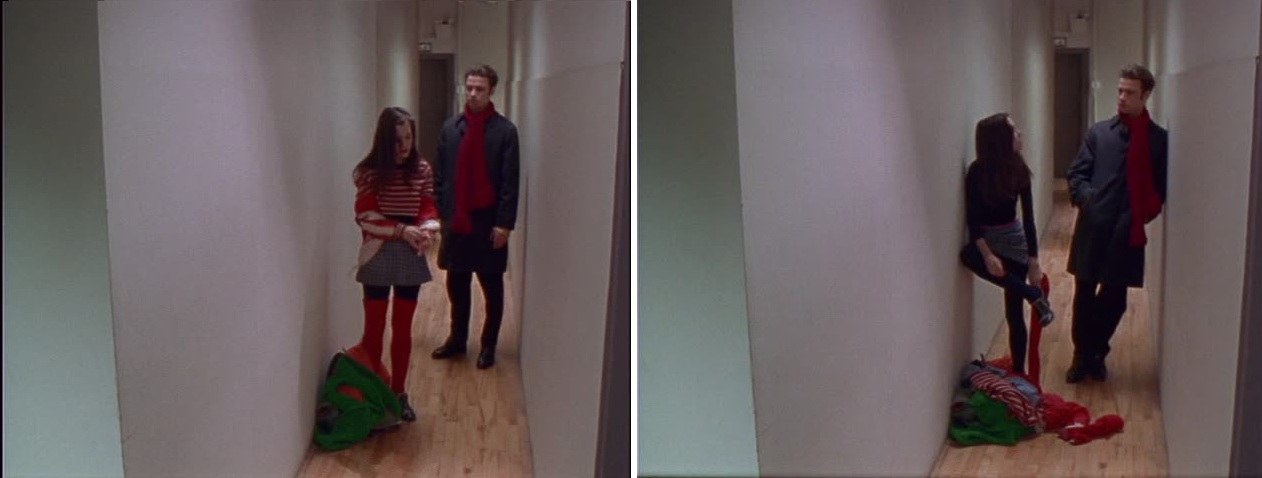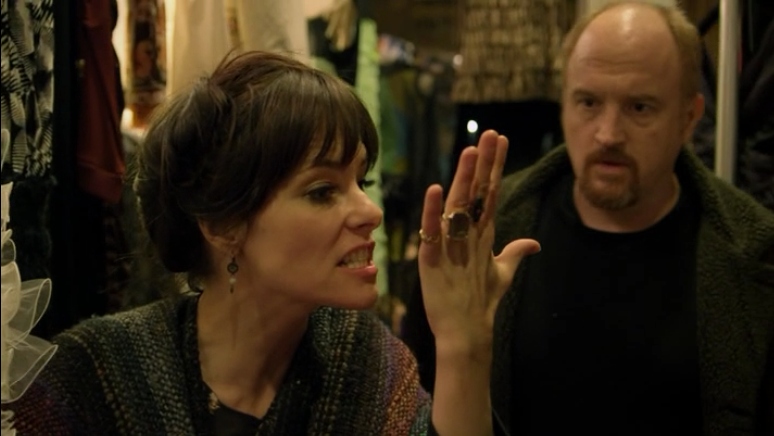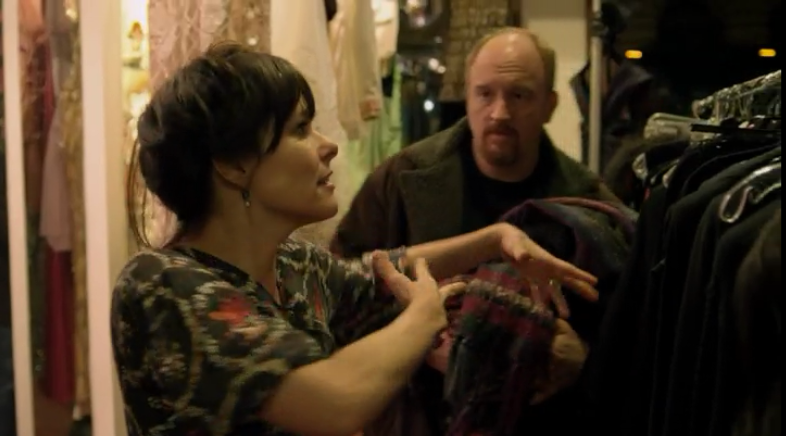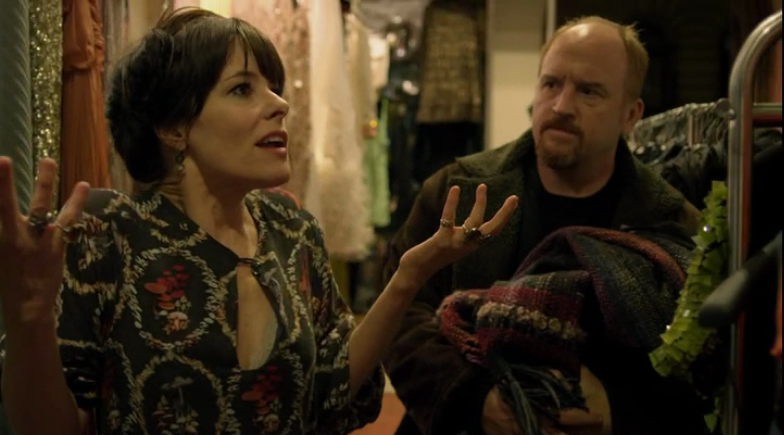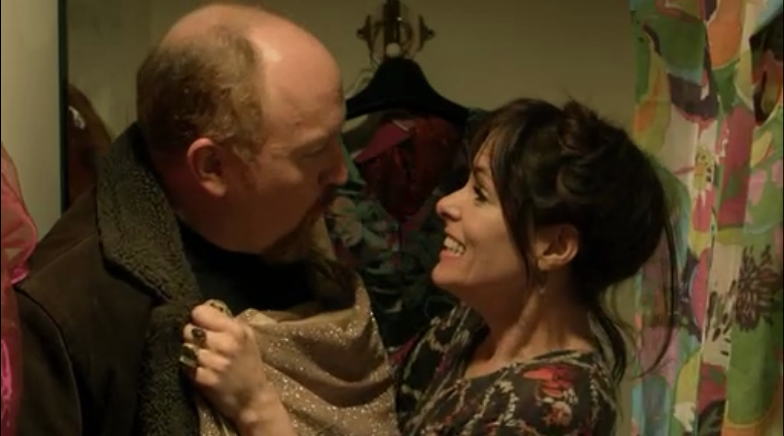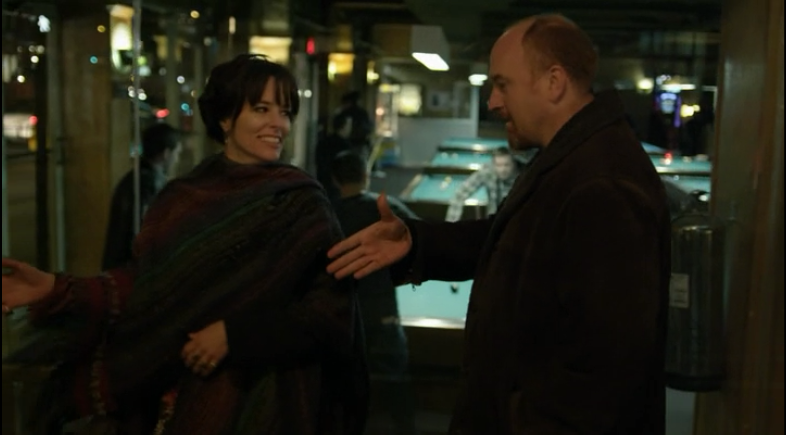Parker Posey: New York Flight
Steven Rybin
“My favorite part of New York,” Liz (Parker Posey) says to her date Louie (Louis C.K.) as they walk down a Manhattan street at night, “is that you can just walk and walk, and you’ll never run out of city.” Unlike Liz, Parker Posey does not require a major metropolis, or even an especially good script, to do interesting performative work. Her devotees know well how she can change the space, with one gesture or glance, of dull Hollywood product – the sorts of films she was obliged to make after the decline of nineties American independent cinema. In You’ve Got Mail (1998), Josie and the Pussycats (2001), and Superman Returns (2006), she darts right past those viewers who have arrived at these films for their plots and their leading stars, all in playful search of those eyes who have arrived at the movie for her.
Those eyes learned to love her in the nineties, when she became the “indie queen” after star turns in Party Girl (1995) and The House of Yes (1997). But unlike other actors – Matthew McConaughey, Renée Zellweger – who successfully made the jump to Hollywood after breaking through in independent cinema, Posey has not found crossover success as a mainstream star. Although she has appeared in a number of Hollywood films (and, increasingly, in guest spots on television), these supporting roles frame her sharp intelligence as an undesirable trait relative to the subservience of the central female characters.[1] (Her turn as Patricia Eden in You’ve Got Mail, a character negatively contrasted to bubbly Meg Ryan, is emblematic in this regard.) Such roles demonstrate a pernicious ideology at work in Posey’s mainstream recasting, wherein, as Diane Negra has written, “the qualities of energy, irony and wit that play sympathetically” in her indie films “take on negative connotations in bigger budget moviemaking.”[2]
Of course, Posey’s lively expressivity has done battle with tired formulas since the very beginning of her screen career. Before Richard Linklater and Hal Hartley cast Posey in early indie roles in Dazed and Confused (1993) and Flirt (1994), she played scheming Southern belle Tess Shelby on a season of As the World Turns (1991-1992). Her fans will want to seek out those episodes; they are campy fun, with Posey bringing knowledge of melodramatic conventions to the part.[3] But her roles in independent films remain her most important because these films share Posey’s own sharp awareness of what becomes possible in her presence. The placement of Posey in New York City is a recurring trope in much of this indie work, including Party Girl, Henry Fool (1997; shot mostly around Queens), the middle chapter of Personal Velocity: Three Portraits (2003), Broken English (2007), and the roles discussed below. Of course, Posey has also occasionally left this city, both on-screen and off-, in order to take especially memorable parts for thoughtful auteurs – including Texan freshman hazer Darla Marks for Linklater in Dazed and Confused,undergrad Miami in Noah Baumbach’s Kicking and Screaming (1995), amateur actress Libby Mae Brown in Christopher Guest’s Waiting for Guffman (1997), and the globe-trotting title character in Hartley’s Fay Grim (2006). But many more of her smartest performative moments are in New York, the city most fitting for the enchantingly flighty presence she inscribes on film.
* * *
Posey herself is not a native New Yorker. Raised in Laurel, Mississippi, she arrived to study acting at SUNY-Purchase in the mid-80s. (Posey claims to have lost her regional accent during college, although her voice is inflected with a southern lilt in occasional roles; see As the World Turns, Waiting for Guffman, and a guest spot on a 2000 episode of Futurama entitled “The Deep South.”[4]) After a series of supporting roles in the early nineties, she had her breakthrough in independent films, leading critics to bestow the moniker of “queen of the indies” upon her.[5] The star persona of the “indie queen,” as Diana Negra points out, blends two key traits with which the city itself came to be identified during these transformative years. Negra suggests Posey’s smart characters exude a self-aware, sarcastic cynicism, traits that came to be associated with New Yorkers in popular culture and which also serve as an implicit critical response to the conservative reshaping of the city in the eighties.[6] In this sense, Posey, although not a native of the city, nevertheless takes implicit inspiration from cinema’s other quintessential “New York girls,” such as Audrey Hepburn’s Holly Golightly in Breakfast at Tiffany’s (1961) and Diane Keaton’s title character in Annie Hall (1977).[7]
Posey also exhibits, in her playing of these New York characters, an uninhibited energy inherited from classical screwball comediennes – a connection her role in The Misadventures of Margaret (1998) makes clear, with its inclusion of posters of My Man Godfrey (1936) and The Awful Truth (1937)in the mise-en-scène of her character’s apartment. As these films remind us, however, the supposedly “screwy” characters played by Carole Lombard and Irene Dunne in the classic genre of screwball are not irrational, but rather operate with their own nimble intelligence. Posey does much the same, creating moments of dizzy discontinuity not because her characters lack smarts, but rather to allow them to create their own form of continuity within – amounting to a witty possession of – their world. Where her Hollywood films ultimately punish her characters’ desires for individuality, her indie films, and especially her indie films in New York, celebrate these desires, and give them chance to take flight.
Writing about her first arrival in New York in 1984 for the anthology My First New York in 2010, Posey seems to have imagined the city as a space for performance from the beginning:
My parents and I arrived from a small town in the Deep South into the city … I looked into all the cars passing us, amazed that it could all exist without people crashing into each other … It all seemed choreographed to me, and unbelievable.[8]
She describes the city as if it were a stage, a place in which to begin carving out a performative personality. Her early role in The Daytrippers (1996), without being biographical in any literal way, has her playing a character who similarly learns to make New York City her own existential theater. She plays Jo, the sister of Eliza (Hope Davis); Eliza suspects husband Louis (Stanley Tucci), a successful Manhattan publisher, may be having an affair, prompting a family daytrip to the city. During their journey, Jo grows increasingly irritated with her boyfriend Carl (Liev Schreiber), a literary posturer who enjoys expressing noxious political views. The first shots of New York City in the film are quite like the choreographed chaos Posey describes in her essay: buses swerving in front of taxis, with car horns and the jackhammering of concrete in the background, all of it a welcome, noisy counterpoint to Carl’s settled views of the world.
And so Jo finds this to be the city where she will finally play with her own identity apart from Carl, an evolution initially signaled in Posey’s various changes of costume. She begins by wearing a light red-and-white jacket, a red-and-white shirt, and red knee socks, and these bright red threads throw her into relief from her surroundings whenever she is glimpsed in the first half of the film:
As the film goes on, the costume’s meaning evolves; Jo may have initially dressed this way to please her boyfriend’s desire for distinction (the color red links her to Carl, who is also wearing a red scarf), but in having our attention drawn to her, we gradually notice contrapuntal gestures and expressions that signal her dissatisfaction with Carl’s ideas. In one scene, Carl leans over in the car to tell Jo’s mother about his absurdly pretentious idea for a bogus existentialist novel; Posey, at the same moment, has Jo sneak a look of derision to Eliza in the backseat, an independently expressive glance of sisterly camaraderie and that will deepen as the film progresses:
Later, while attending a party for one of her father’s authors, she sheds the red in favor of a hip, literary black that redirects our attention further away from Carl to Jo’s ideas:
In You’ve Got Mail, Posey’s character is dressed in a similar manner, but in that film her style and intelligence are framed negatively, as part of the neuroses of the sort of woman everyman Tom Hanks must break away from in order to live a happy life. In The Daytrippers, Jo’s evolution of style is seen in positive terms, and it motivates her decision to break off from Carl’s limited views of the world.At the end of the film, she leaves Carl and expresses her desire to return to the city and to the imaginatively free life also found by the woman playing her, in the same city, more than a decade earlier.
The Daytrippers and other early films establish the typical Posey character as a crafter of her own identity, whose choices in gesture and dress enable her own energetic movement through the city. Many of her other films set in New York City – Party Girl, Drunks (Richard Lewis, 1995), and Basquiat (Julian Schnabel, 1996) – find Posey playing characters more firmly established in the city than Jo. But this does not limit the expressive freedom of Posey or the characters she plays. Take, for example, Drunks, a fictional series of monologues at an Alcoholics Anonymous meeting in a Times Square basement. Her monologue, as recovering alcoholic Debbie, unfolds across a series of close-ups and medium shots, her fixed, seated position throwing into relief jutting bursts of expressivity (such as the quick movement of her hands, the inflection of her voice, the nod of her head). As she shifts from slightly melancholic recollection to playful gesturing (and then back again) Posey not only embodies the conflicted emotions of a human being struggling to overcome alcoholism, but also conveys the pleasure Debbie takes in assuming control over the meaning, and future direction, of her experience.
She begins by sharing a story about an alcoholic blackout in which she unwittingly married a man named “Wild Bob”:
Debbie: So I guess I was Mrs. Wild Bob. Hello, everyone, welcome to my life! Do you Debbie, take Wild Bob to be your lawfully wedded husband? I do!
Posey blends these four sentences into one rapid-fire breathless run-on, the speed of her delivery bringing the words back to Debbie like a boomerang, every detail in the character’s story blending excitedly into the next. Each transition in the personal narrative Debbie crafts motivates choices and shifts in Posey’s own performative style. While Posey speedily speaks through her character’s marriage to musician “Wild Bob,” as if to reflect her ongoing effort to leave the past behind, Debbie’s admiration of Janis Joplin, the subject of the next part of the monologue, invites relatively unhurried performative play. An accompanying cut to a long shot gives Posey more room to bounce her head left-to-right, her intermittent puffs and expressive handling of a cigarette suggesting that this performance-within-a-performance is ultimately for her character’s own pleasure:
As Debbie’s nostalgic appreciation of Joplin makes clear her desire to have grown up in the liberated sixties rather than the conservative eighties, Posey’s arms and hands – intermittently jutting into space, just now, reflexively returning to a fixed and bound position close to her body, a beat later – convey the mix of containment and freedom her character experiences at any given moment, a set of physical gestures echoing the earlier boomerang effect of the dialogue:
As Debbie’s associative free-play takes her to the next subject of her monologue, her newfound appreciation of professional football, Posey finds incrementally increased freedom in her character’s gesturing. Posey relaxes back in her seat and extends her hands to the side and front, inviting her audience to share her character’s pleasure in sports through the appreciation of her own bodily and gestural energy:
Posey then ties all of the various threads of the monologue together, returning to the subject of Janis Joplin with a reflective inflection in the character’s voice. The sequence ends with Posey puffing on her cigarette once more, a punctuation mark on the sequence and confirmation of the pleasure her character has taken in momentarily taking hold of the emotional space of this Alcoholics Anonymous meeting.
Of course, in characterizations of damaged women like Debbie, there is the danger that the performance might become associated with psychological disturbance, rather than existential freedom. Posey is certainly no stranger to unstable characters. Her celebrated turn as a troubled mimicker of Jacqueline Kennedy Onassis in The House of Yes is a rather literal and dark variation on the “madcap heiress” tradition established in classical screwball comedies – the kind of performance that delightfully justifies Alissa Quart’s quip that Posey is something like “Katharine Hepburn on a lot of methamphetamines”.[9] This perceived lack of mental stability is also part of Posey’s own biographical legend; when a 1996 interview turns to the subject of her early childhood and twin brother, she reveals that
…I was a dreamer. I was kind of strange. I was very absent-minded. My parents thought I had a learning disability … And plus I was three months premature. The doctors told my parents that their children could very possibly be retarded, and to hold them back a year in school. So my parents were on the lookout to see if their kids turned out to be mental cases. And I did, and my [twin] brother didn’t.[10]
Louis C.K., in his casting of Posey for a guest turn on Louie, evokes this element of mental disturbance in her persona, but in ways that are more optimistic than either Drunks or The House of Yes. Indeed, although Louie is produced for a mainstream cable network, Posey’s guest role in the third season of the series has much in common with her indie characters. Posey plays Liz, a bookstore clerk who meets Louie when he stops by to pick up a book for his daughter. Their first date comprises the narrative arc of “Daddy’s New Girlfriend, Part 2,” the second episode in Posey’s four-episode arc and the one in which she commands the most screen time. Early in the date, Liz reveals to Louie that, as a teenager, she underwent chemotherapy. Although she has since recovered, the off-kilter framing and jump cuts suggest lingering psychological effects, accompanied by shots of Louie looking rather befuddled at Liz’s behavior. Her words are accompanied by discordant music on the soundtrack, amplifying our sense of the character’s troubled state.
But Liz’s sudden revelation of her tortured past is not the focus of the episode, or the performance. While certainly injecting an unexpected discontinuity into the date, Liz’s past life ultimately acts as a springboard upon which Posey can launch Liz into her own form of continuity. Posey places Liz’s excitement and energy close to the surface, ensuring that Louie and the audience must breathlessly move forward to catch up with her. Her performance thus moves beyond the conveyance of her character’s past, establishing instead (within this single episode) a present-tense space into which the viewer (and hapless Louie) cannot help but follow her.
Liz’s thirst for life is most powerfully conveyed by Posey through a series of interconnected moments. After revealing her earlier trauma, Liz guides Louie into a vintage clothing store. Describing her near-death experience as a teenager like it were a personage, she brings her hand close to her face, as if the creature she has conjured were something encountered in the present moment:
As she narrates her sudden recovery, her hands flow freely into the space in front of her, a description of how (as she puts it) “death backs away into the mist” after a long illness:
Liz’s own ability to be surprised and revitalized by the facts of her own biography are made clear as she raises her hands to the ceiling in wonderment:
Liz continues moving down the aisle. Louie wants to know more about her teenage years, but Liz has already jumped into the next moment. She spies a dress she likes on the rack, and then leaps out of frame. A beat later, she returns, and shows the dress admiringly to Louie, gazing at him with mischievous desire: she wants him to try it on. Louie, as if to try to guide them back to rationality, wants to know why. Liz reacts with indifference towards his demands for reason. Posey’s performance embodies the true subject of the scene: Liz’s willful discovery of yet one more moment of life-affirming energy. She pushes the dress against Louie with her hands and, bouncing up and down, smiles beamingly, all to convey that this moment of uncomfortable but radiant ambiguity requires no justification beyond the very heartbeat of Posey’s performative vitality:
The energy she has found is the reason. Liz has no grand narrative goal; she means only to find shared joy in moments of pure performative presence, and make way for the next disruption of plan.
The juxtaposition of the two performances is a comic delight. Louis C.K. uses mostly bound and fixed gestures, his hands and arms remaining close to his torso while Posey uses free-flowing movements of head, arms, and body. The image below, from later in the episode, perfectly illustrates this contrast; Louie attempts to guide Liz back to his “bound,”[11] risk-wary body through a handshake, while Posey has Liz guide Louie freely forward to the next adventure:
* * *
Posey’s performances in The Daytrippers, Drunks, and Louie confirm New York City as the place where she most vividly discovers her characters’ delightful, existentially free movement. It is unimaginable, to borrow a phrase from Liz, that Posey will ever “run out of city.” If the city street ends, she’ll just conjure the expression or gesture necessary to imagine another space, springing in that general direction.
*
With thanks to Patrick Cagle.
Steven Rybin is an assistant professor of film at Georgia Gwinnett College. He is the co-editor of Lonely Places, Dangerous Ground: Nicholas Ray in American Cinema (SUNY Press, 2014) and author of Michael Mann: Crime Auteur (Scarecrow Press, 2013), among other books, book chapters, and articles. He is currently writing a book on the performance of courtship in classical Hollywood cinema.
[1] Diane Negra makes a similar point in “Queen of the Indies: Parker Posey’s Niche Stardom and the Taste Cultures of Independent Film,” in American Independent Cinema: Indie, Indiewood, and Beyond (New York: Routledge, 2013), 71-88.
[2] Diane Negra, “Queen of the Indies,” 83.
[3] Posey discusses her experiences on the show in Christina Kelly, “Parker Posey, 1996,” Index Magazine (1996), http://www.indexmagazine.com/interviews/parker_posey.shtml.
[4] Christina Kelly, “Parker Posey, 1996.”
[5]Richard Corliss and Jeffrey Ressner, “Queen of the Indies,” in Time 149, no. 7 (17 February 1997), 82.
[6]Diane Negra, “Queen of the Indies,” 78-80.
[7]Diane Negra, “Queen of the Indies,” 80.
[8]Parker Posey, “1984,” in My First New York: Early Adventures in the Big City, eds. David Haskell and Adam Moss (New York: Harper Collins, 2010), 161-162.
[9]Alissa Quart, “Who’s Afraid of Parker Posey?”, in Film Comment 38, no. 6 (Nov/Dec 2002), 42.
[10] Christina Kelly, “Parker Posey, 1996.”
[11]The contrast between “bound” performance styles and “free-flowing” performance styles, as defined by Laban’s theories of performance, is discussed at length in the eighth chapter of Reframing Screen Performance, eds. Cynthia Baron and Sharon Marie Carnicke (Ann Arbor: The University of Michigan Press, 2011), 188-207. My use of these terms in this essay is informed by this book.

